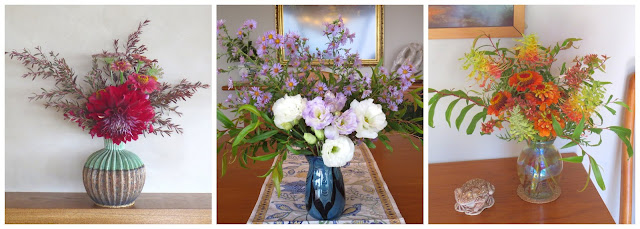The garden and I reach a low point in August. Even in good years (namely, those with decent rainfall), the garden looks badly stressed by this time of year. I usually spend a lot of time dispensing emergency rations of water but this year, with virtually the entire State of California in severe drought, I think twice before administering any aid. I gave the lemon tree at the bottom of our slope, which I suspect has been in place for 25 or more years, a good soak last Saturday when my husband (who usually pays no attention to plants) expressed concern that it was dying. Two days ago, I accepted the fact that my favorite Correa, 'Sister Dawn', planted in 2018, was dead. Large sections of creeping thyme in various areas have died out. I could go on. Wishing to avoid the bleak newscasts for at least awhile, I decided to see what I could accomplish in the garden to put a positive spin on its appearance.
Rather than tackle one of the areas that looks really bad, I decided to start with an area that looks relatively good. My hope was that, with a little work, it could look even better.
 |
| This is the dry garden on the northeast side of the house. The issues here aren't readily apparent in this wide shot. |
 |
| Even in this closeup shot, the problem may be hard to see. But there's a large, nearly invisible Agave ovatifolia lurking behind that Cistus shrub in the center. |
 |
| The whale's tongue agave and the octopus agave next to it are still visible in this rear view photo, taken partway down the concrete stairway that leads to the back slope but, with the Callistemon viridiflorus in the foreground getting larger, that may not be the case for long |
My first objective was to remove the Cistus 'Victor Reiter' I'd planted from a 4-inch pot in 2016. It grew taller than I'd envisioned and didn't get enough sun to bloom well, and of course it was blocking the view of my oldest Agave ovatifolia. I thought of relocating it but I didn't have an immediate placement in mind so I took cuttings instead.
 |
| I took twenty cuttings in all, storing them in this area behind the garage that gets only morning sun. This is admittedly not the best time of year to take cuttings but I hope at least a few will root. |
Other than periodically getting poked by the nearby agaves, the Cistus came out with relative ease. Agave ovatifolia regained its rightful place as a focal point.
 |
| Ta-da! |
 |
| And here's a closeup from the same vantage point used in my second photo |
There's now an empty space in front of the agave that needs to be filled. There are half a dozen agave pups I can't identify there but I'll probably pot them up to give away as they're too small to have any impact. I noticed I have grass seedlings in another section of this area so I may transplant one or two of those here.
 |
| NoID agave pups. There are several other agaves nearby, any of which might be the parent. |
 |
| I'm fairly certain that this grass seedling is Melinus nerviglumis (aka ruby grass). Unlike the Cistus, it doesn't get very big so it might be a good fit in the empty spot in front of Agave ovatifolia. |
After a midday break, I tackled cleanup of the area behind the Agave ovatifolia. In addition to pulling weeds, I trimmed back rosemary and lightly pruned both the 'Hachiya' persimmon tree (currently laden with fruit) and Coprosma repens 'Plum Hussey'.
 |
| As shown in the "before" shot on the left, the tall Coprosma was interfering with the massive arms of Agave vilmoriniana. The photo on the right was taken after I cleaned things up. |
I pulled out a lot of self-seeded Dorycnium hirsutum (aka Hairy Canary Clover), potting up one viable seedling to fill an empty space where another clover died last year.
 |
| Assuming the seedling on the left survives being roughly yanked out the ground, I'll transplant it in the empty spot shown on the right once our rainy season (hopefully) starts |
Dorycnium is a lovely plant in and out of bloom but it's a rampant self-seeder and a vigorous spreader. I cut back some of the plants swamping other plants during my cleanup operation as well.
 |
| The photo on the left shows a clover covering a clump of grass and infringing on nearby agaves. The photos on the right show the clover in two areas after it was cut back. |
The ivy growing into the area from the back slope needs to be cut back as well but that's a job for another time. At least the day's cleanup effort left me in a more positive frame of mind. I can't solve climate change or the world's other problems but at least I can accomplish little things that improve the appearance of my garden. Best wishes for a pleasant weekend.
All material © 2012-2021 by Kris Peterson for Late to the Garden Party






















































